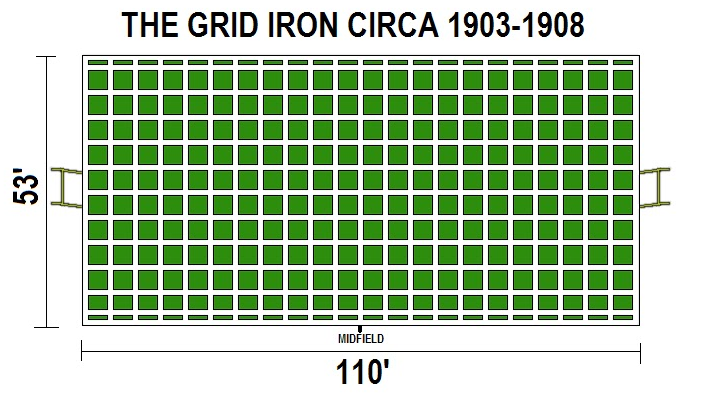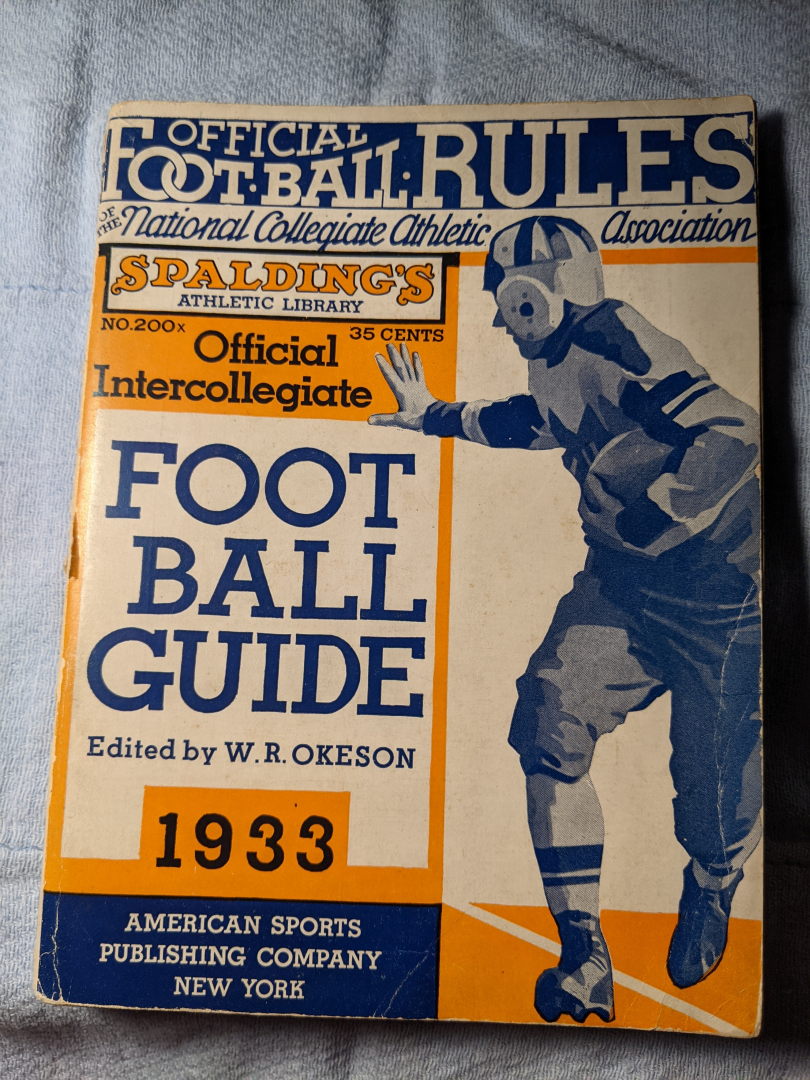We look at them every time we watch a game, and they are important yet somewhat in the background of our focus. The football field markings are everywhere on the playing surface but what are they used for and where did they come from? We hope to give you these answers today to fill that football brain with knowledge.
Football Field Lines
Goal lines and Side lines
Probably the most prominant and decorative field marks are found in and around the endzones. The goal line itself is one of the earliest field markings as it goes back to the roots of soccer and rugby. According to Parke H. Davis in his 1911 transcript Football: the Intercollegiate Game, the Spartans played their game called “harpaston” which was played on a rectangular field that had two side lines, two goal lines and a centerline. Records are not real clear on just how these lines were marked, but we can imagine that they probably varied from lines etched into the turf to some crushed stone or sand deposits to boundary monuments to identify these lines. These lines throughout history in all of the games that came thereafter were field boundaries identifying where the playing surface was and where it ended. The centerline was used for different purposes but most notably had the same basic meaning it has in today's gridiron games, to set the filed into two hemispheres, one for each team to call their own and defend.
The endzone was not officially identified until a 1912 rule added a ten yard deep end zone at each end protruding past the goal line, which would have suggested making the fields an extra 20 yards longer beyond the area inside the goal lines. Since this size would not fit in many of the college stadiums that had already been built it was decided to make the American field be 100 yards goal line to goal line with another 20 yards spared for the end zones. Thus the basic size of the field was created for the modern game. In Canada they have kept their fields at 110 yards long from goal to goal and then added 20 yard deep endzones.
The yard line chalk
In 1882 lines were installed to the field at every five yards in between the goal lines to aid with rules of the time. After all when Walter Camp introduced the elements of scrimmage, down and distance the field needed to aid officials and everyone else on where they were at on the field to start and where they had to go to achieve a first down. These lines were expanded to go from goal line to goal line too in photos from 1903 to 1911 as college rules makers were desperately trying to tame the game due to excessive injuries and deaths raising public outcry to get rid of the game altogether. This era of the football field is fondly known as the "checker-board" years. The criss-cross lines formed a “grid” pattern and soon the name “gridiron” was coined to describe the look of the field. The credit to the game being called Gridiron is credited to a 1911 article in Outdoor Sports and Games, by Claude H. Miller. The original purpose of the extra lines were for penalty enforcement based on how far away an offense was to the ball carrier. These lines eventually faded away with later rule revisions but did give way to hash marks and the nine yard marks (the tops of the numbers) being used in 1933.

Hash mark history
Yes it was a 1933 rule that had a big impact on the game of football. The rule added hash marks to the playing surface. Prior to 1933 when a runner was tackled near the side line or even when they went out of bounds, the ball would be spotted where they were downed or extremely close to the side line. There are many instances recorded on football history where the snapper was the closest offensive player to the sideline! Imagine that. It made it pretty evident where the offense would have to have their next play go, the wide side of the field. Defenses understood the dilemma of their counterparts and set their formations to defend the side away from the side line with more of their eleven players to the larger area of the field than the other. The old way of spotting the ball caused other complications as well such as in the kicking game for obvious reasons. I invite you to check an excelent article written by Timothy Brown on the Fields of Friendly Strife website in 2018.

The 1933 Spalding Official NCAA Football Rules Guide state that there must be short lines on each of the lines parallel to the goal lines that intersect perpindiculary. These of course would later be known as the hash marks. LAter in the 1933 NCAA rule book says that if the play ends out of bounds or closer than ten yards from either sidel line then the next play will be snapped at a point ten yards fromthe closest side line indicated by the short perpindicular lines on the field.
The numbers
The big bold numbers found on many football fields these days have a couple of functions. The obvious one is that they indicate which ten yard increment they are stationed on. It leaves little to wonder when the ball is placed on a line that has a giant 40 written on it in a couple of places. However the numbers have another more hidden purpose as well. The tops of the numbers on most fields are positioned to be exactly nine-yards from the side line. These are also referred to as the nine-yard marks. This is iportant for substitution rules at most levels. To clearly be a legal player, one of the eleven on offense, all players would have had to be inside the nine yard marks after the ready for play signal by the Referee and before the snap. They do not have to line up inside this area but they do have to physically enter it, either by going to the huddle or simply stepping inside of the boundary and then going to a position outside of the numbers. They can also go in motion or shift to become legal by rule. This prevents the old player coming off of the sideline and standing there near his team's box, unnoticed by the defense, to gain a deceptive advantage of having an uncovered eligible receiver.
The game of American football is quicly identified by some of its unique equipment that provide safety for players or fairness and metrics to participants. The evolution of this equipment has been wide sweeping and abrupt in some cases as new rules, technology, innovation, and new materials have become available to the gridiron.
Frequently Asked Questions About Football Fields
-How long is a football field? A football field from goal line to goal line is 100 yards long with two ten yard deep end zones. Want to know more about the evolution of the playing field, you are in the right place as we covered it here: Field Size Evolution.
-How wide is a football field? Most levels of American football play on a field that is 53.3 yards wide.
-What are the hash marks for? The hash marks are used for a few different things during a game, but most importantly, they are the inbounds spot for the ball to rest of the next play adjacent to where it became dead on the previous play outside of the hash marks or out of bounds. Here is a great piece explaining the has marks and their history and evolution: The Fumble Fiasco Out-of-Bounds Oddities in Early Football.
-What do the yard lines mean? On an American football field, each line has unique qualities. Lines that extend from sideline to sideline include the goal lines, and significant yardage milestones from each goal line are set at 5-yard increments, with smaller lines in between giving distances at one yard each. Check out this post Football Lockney Lines
-How big are the end zones? Each end zone is ten yards deep.
The Photo Credits
The picture in the banner above is from the U.S. Library of Congress digital collection. The photo was taken in 1922 at the Navy versus Penn State football game by photographers Harris and Ewing.


